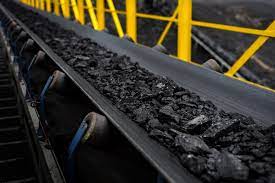
(1)Belt conveyor

The belt conveyor is composed of a driving device, a tensioning device, a middle frame of the conveyor belt and an idler, and the conveyor belt is used as a traction and bearing component, so as to continuously convey loose materials or finished products.
A belt conveyor is a friction-driven machine that transports materials in a continuous manner. It can be applied to form a material conveying process on a certain conveyor line, from the initial feeding point to the final discharge point. It can not only carry out the conveying of broken bulk materials, but also the conveying of finished items. In addition to pure material transportation, it can also cooperate with the requirements of the process in the production process of various industrial enterprises to form a rhythmic assembly line transportation line. Therefore, belt conveyors are widely used in modern industrial enterprises.
Belt conveyors are widely used in underground mine tunnels, mine surface haul systems, open-pit mines and concentrators. It is used for horizontal or inclined transportation.
The general belt conveyor is composed of conveyor belt, idler, roller and drive, braking, tensioning, redirection, loading, unloading, cleaning and other devices.
(1) Conveyor belt
There are two commonly used types: rubber belt and plastic belt. The rubber belt is suitable for working environment temperature between -15~40°C. The temperature of the material does not exceed 50°C. The inclination angle of upward conveying bulk material is 12°~24°. For conveying at large inclination angles, patterned rubber belts can be used. Plastic tape has the advantages of oil resistance, acid, alkali and so on, but it has poor adaptability to the climate and is easy to slip and age. Bandwidth is the main technical parameter of the belt conveyor.
(2) Idlers
It is divided into single drum (the wrapping angle of the tape to the drum is 210°~230°), double drum (the wrapping angle is up to 350°) and multiple rollers (for high power), etc. There are trough idlers, flat idlers, self-aligning idlers, and buffer idlers. The trough idler (composed of 2~5 rollers) supports the bearing branch to convey bulk materials; The self-aligning roller is used to adjust the transverse position of the belt to avoid deviation; The buffer roller is installed at the receiving place to reduce the impact of the material on the belt.
(3) Roller
It is divided into drive drum and reversing drum. The drive drum is the main component that transmits power.
(4) Tensioning device
Its function is to make the conveyor belt reach the necessary tension to avoid slipping on the drive roller, and to ensure that the deflection of the conveyor belt between the rollers is within the specified range.
Advantages of the belt: The first is that it operates reliably. Belt conveyors are used in many important production units that require continuous operation, such as the transportation of coal in power plants, the transportation of bulk materials in steel and cement plants, and the loading and unloading of ships in ports. In the event of a shutdown in these cases, the cost is enormous. When necessary, the belt conveyor can work continuously from shift to shift.
The belt conveyor has low power consumption. Because the material and the conveyor belt have almost no relative movement, it not only makes the running resistance small (about 1/3-1/5 of the scraper conveyor), but also the wear and crushing of the load are small, and the productivity is high. All of these are conducive to reducing production costs.
The conveyor line of the belt conveyor is adaptable and flexible. The length of the line depends on the need. It can be as short as a few meters and as long as more than 10 km. It can be installed in small tunnels or erected over areas where ground traffic is chaotic and dangerous.
Depending on the requirements of the process, the belt conveyor can receive material from one or more points very flexibly. It is also possible to discharge to multiple points or several sections. The belt conveyor becomes a major conveyor line when material is fed to the conveyor belt at several points at the same time (such as a conveyor under the coal bunker in a coal preparation plant) or at any point along the length of the belt conveyor through a uniform feeding device.
Belt conveyors can be used to pick up material in the tunnel below the stockpile in the coal storage yard and, if required, to mix the different materials in the pile. Material can be simply discharged from the conveyor head or at any point along the length of the belt by a plow discharger or mobile dump truck.